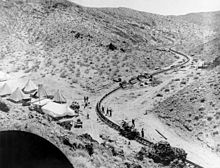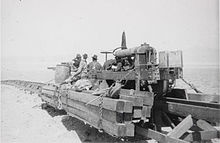
A monorail is a railway in which the track consists of a single rail or beam. Colloquially, the term "monorail" is often used to describe any form of elevated rail or people mover. More accurately, the term refers to the style of track. Monorail systems are most frequently implemented in large cities, airports, and theme parks.

Magnesium sulfate or magnesium sulphate is a chemical compound, a salt with the formula MgSO4, consisting of magnesium cations Mg2+ (20.19% by mass) and sulfate anions SO2−4. It is a white crystalline solid, soluble in water but not in ethanol.

Epsomite, Epsom salt, or magnesium sulfate heptahydrate, is a hydrous magnesium sulfate mineral with formula MgSO4·7H2O.
The Cartier Railway is a privately owned railway that operates 260 miles (418 km) of track in the Canadian province of Québec.
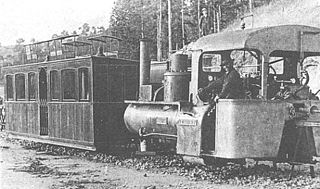
The Lartigue Monorail system was developed by the French engineer Charles Lartigue (1834–1907). He further developed a horse drawn monorail system, which had been invented by Henry Robinson Palmer in 1821.

Searles Lake is an endorheic dry lake in the Searles Valley of the Mojave Desert, in northwestern San Bernardino County, California. The lake in the past was also called Slate Range Lake and Borax Lake.
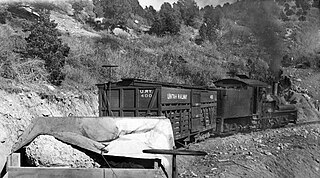
The Uintah Railway was a small 3 ft narrow gauge railroad company in Utah and Colorado in the United States. It was constructed to carry Gilsonite which provided most of its operating revenues; but it operated as a common carrier from 1904 to 1939, also carrying passengers, mail, express, and other cargoes including sheep and wool. When a public library was built in Dragon in 1910, the Uintah Railway agreed to deliver library books free of charge to and from any borrower along its route. Many area ranchers and miners took advantage of the opportunity.
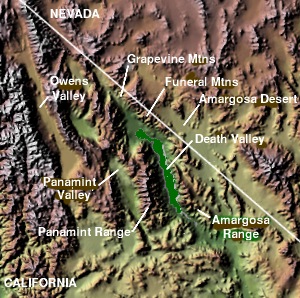
The Panamint Valley is a long basin located east of the Argus and Slate ranges, and west of the Panamint Range in the northeastern reach of the Mojave Desert, in eastern California, United States.

The Trona Railway is a 30.5 mi (49.1 km) short-line railroad owned by Searles Valley Minerals. The TRC interchanges with the Lone Pine Subdivision of the Union Pacific Railroad at Searles, California.

Catch Me Who Can was the fourth and last steam railway locomotive created by the inventor and mining engineer Richard Trevithick. It was an evolution of three earlier locomotives which had been built for Coalbrookdale, Penydarren ironworks and Wylam colliery. Demonstration runs began in July 1808, and Catch Me Who Can was the first locomotive in the world to haul fare-paying passengers.
The Eagle Mountain Railroad (EMRR) was a private railroad in California, owned by the Kaiser Steel Corporation, and is owned today by Kaiser Steel's successor, Kaiser Ventures, Inc. of Ontario, California.
The term monorail or industrial monorail is used to describe any number of transport systems in which a chair or carrier is suspended from, or rides on, an overhead rail structure. Unlike the well-known duo-rail system, there are many rail-guided transport options which have been described as monorails, so that tracing the history presents a demarcation problem regarding what should be included and what should be omitted.
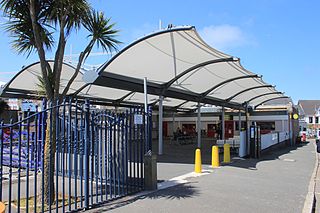
Newquay railway station serves the town and seaside resort of Newquay in Cornwall, England. It is the terminus of the Atlantic Coast Line from Par, 302 miles 49 chains from the zero point at London Paddington measured via Box and Plymouth Millbay. The station is situated in the heart of Newquay, close to the town centre itself and the beaches. The station is managed by Great Western Railway which operates local branch line services to and from Par. In the summer, there are also services to and from London.

The Scott Special, also known as the Coyote Special, the Death Valley Coyote or the Death Valley Scotty Special, was a one-time, record-breaking passenger train operated by the Atchison, Topeka and Santa Fe Railway from Los Angeles, California, to Chicago, Illinois, at the request of Walter E. Scott, known as "Death Valley Scotty". At the time of its transit in 1905, the Scott Special made the 2,265-mile (3,645 km) trip between the two cities at the fastest speed recorded to date; in doing so, it established the Santa Fe as the leader in high-speed travel between Chicago and the West Coast. The Scott Special made the trip in 44 hours and 54 minutes breaking the previous records, set in 1900 by the Peacock Special, by 13 hours and 2 minutes, and in 1903 by the Lowe Special, by 7 hours and 55 minutes. Santa Fe's regular passenger service from Los Angeles to Chicago at the time was handled on a 2½-day schedule by the California Limited. It was not until the 1936 introduction of the Super Chief that Santa Fe trains would regularly exceed the speeds seen on the Scott Special.

The San Bernardino train disaster, was a combination of two separate but related incidents that occurred in San Bernardino, California, United States: a runaway train derailment on May 12, 1989; and the subsequent failure on May 25, 1989, of the Calnev Pipeline, a petroleum pipeline adjacent to the tracks which was damaged by earth-moving equipment during the crash cleanup.

A predecessor to the Class I Delaware and Hudson Railway, the 1820s-built Delaware and Hudson Canal Company Gravity Railroad('D&H Gravity Railroad') was a historic gravity railroad incorporated and chartered in 1826 with land grant rights in the US state of Pennsylvania as a humble subsidiary of the Delaware and Hudson Canal and it proved to contain the first trackage of the later organized Delaware and Hudson Railroad. It began as the second long U.S. gravity railroad built initially to haul coal to canal boats, was the second railway chartered in the United States after the Mohawk and Hudson Rail Road before even, the Baltimore and Ohio. As a long gravity railway, only the Summit Hill and Mauch Chunk Railroad pre-dated its beginning of operations.

Patiala State Monorail Trainways (PSMT) was a unique rail-guided, partially road-borne railway system running in Patiala from 1907 to 1927. PSMT was the second monorail system in India, after the Kundala Valley Railway, near Munnar in Kerala, and the only operational locomotive-hauled railway system built using the Ewing System in the world. The Kundala Valley Railway pre-dated this, also using the Ewing system between 1902 and 1908, although this only used bullocks for haulage. Following the conversion of the Kundala Valley Railway from a monorail to a narrow gauge railway in 1908, PSMT was the only monorail system in India until its closure in 1927. These were the only instances of a monorail train system in India, until the Mumbai Monorail was opened on 2 February 2014.

Trona is an unincorporated community in San Bernardino County, California. In 2015 it had a population of approximately 1,900. Trona is at the western edge of Searles Lake, a dry lake bed in Searles Valley, southwest of Death Valley. The town takes its name from the mineral trona, abundant in the lakebed. It is about 170 miles (274 km) northeast of Los Angeles, on State Route 178. The ZIP code is 93562.

The Aldershot narrow-gauge suspension railway was built in 1872 as an innovative experimental railway at Aldershot Camp in Hampshire, England. It had a gauge of 18 in and incorporated the suspension principle, invented and patented by John Barraclough Fell.

The Yarlside Iron Mines tramway or Parkhouse Mineral Railway was built as a one-mile (1.6 km) long innovative railway from the Parkhouse Haematite Ore Mines to the Roose railway station on the Furness Railway, then in North Lancashire, now in Cumbria, England. Similar to a monorail, it had stabilising side rollers, invented and patented by John Barraclough Fell.

